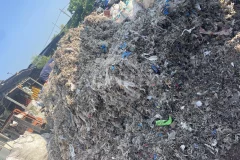
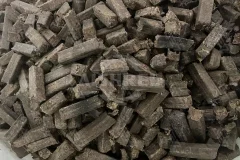
Resourceful treatment of paper mill strand rope is a comprehensive process aimed at converting solid wastes such as strand rope produced in the papermaking process into valuable resources in order to reduce environmental pollution and realize effective recycling of resources. The following is a detailed description of the paper mill strand rope resource treatment:01.Pre-preparation and estimationStranded rope is a paper mill in the paper making process, hydraulic pulper in the stranded rope will be waste paper pulp in a variety of light impurities, such as wire, plastic, fine rope, cotton yarn, etc. constantly winding stranded set and become a stranded rope, that is, stranded rope. It is also called twisted rope pulp residue, pulping tail rope, which contains 40% of iron wire and 55% of paper mill waste, as well as pulp residue and light residue, belonging to a kind of material difficult to be broken. 02.Processing flowShreddingPaper mill stranded rope is fed into double shaft shear shredder through conveyor
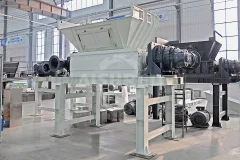

Industrial waste is composed of waste generated during the industrial production process, which can be in the form of solid, liquid, or gas. The industrial waste we usually refer to mainly refers to industrial solid waste. These industrial wastes need to be properly treated to reduce their impact on the environment and human health. Common treatment methods include recycling and reuse, incineration for energy conversion, landfill, etc.Converting industrial solid waste to Renewable Fuel, RDF is a feasible waste disposal method. RDF is a combustible fraction extracted from waste, typically used for energy production such as power generation or heating.The following are the general steps for converting industrial waste into RDF:1. Collection and Classification:Firstly, industrial waste needs to be collected and classified. The purpose of classification is to separate combustible and non combustible parts for subsequent processing.2. Shredding or Crushing:The collected industrial waste will be sent to a shredder
At present, organic industrial waste generated by industries such as garment, shoe-making, tanning, textile, clothing, leather goods, packaging and plastic products mainly contains high concentrations of organic matter and some heavy metals. The common treatment method is direct incineration, but due to insufficient combustion, it is easy to cause serious secondary pollution and difficult to meet environmental standards. Processing these wastes into homogeneous and easy-to-burn refuse-derived fuels is another treatment method. However, such organic industrial wastes have problems such as poor adhesion and molding difficulties, and the organic matter in them may contain acid and sulfur, which may cause pollution in subsequent processing and fail to meet environmental protection requirements. To improve on these shortcomings of existing technologies, AI Shred has introduced a new process for the preparation of refuse-derived fuels. This process has excellent adhesive properties and easy molding characteristics
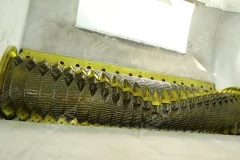
Enhancing Industrial Waste Management with Double-Shaft Shredders and Single-Shaft Shredders
2023-10-31Industrial waste management plays a crucial role in maintaining a clean and sustainable environment. With the advancing technology, the implementation of double-shaft shredders and single-shaft shredders has proven to be a highly effective solution in efficiently processing and disposing of industrial waste. This article aims to explore the benefits and optimization opportunities presented by these shredding machines in industrial waste management.Double-Shaft Shredders:Double-shaft shredders are robust machines that operate with two interlocking cutting shafts. These shredders excel in handling a wide variety of industrial waste materials such as plastics, rubber, wood, and metals. The unique design and cutting mechanism of double-shaft shredders enable them to achieve high throughput and consistent particle size reduction, making them ideal for large-scale industrial waste processing facilities.Advantages:Versatility: Double-shaft shredders can efficiently process various types of industrial waste,
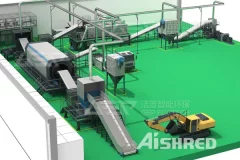
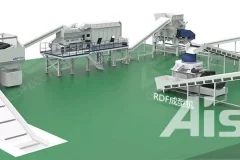
"Eat" into waste, "vomit" out of fuel, and become a "artifact" that turns waste into treasure in Zhengzhou, Henan. The Industrial Solid Waste Disposal System produced by GEP ECOTECH can "eat" 20 tons of C&I waste in one hour and produce preparations Popular alternative fuel RDF/SRF. So what craftsmanship does GEP ECOTECH make "people suspected" and make the waste into the "fragrant" of the fuel industry?Waste is an abandoned item that loses its value and cannot be used. It is the ultimate part of the material cycle. The widely used waste treatment methods today are sanitary landfills, high temperature compost and incineration. However, most of the industrial waste incineration contains considerable heat values, and directly landfills or incineration undoubtedly causes waste of resources. Now, this industrial solid waste disposal system located in Zhengzhou, Henan can effectively use general industrial solid waste such as leather edge, cloth edge corner, waste paper residue, waste fabric, waste plastic, etc
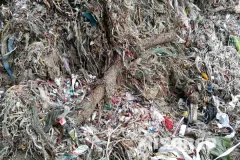
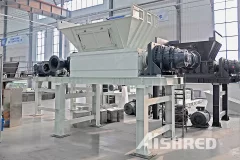
Paper Mill Waste Utilization Direction: Convert to RDF using the AIShred Industrial Waste System
2023-02-26According to statistics, the paper waste residue produced by a recycled paper production plant with an annual output of 1.5 million tons is about 180,000 tons/year or more. When paper mills use recycled materials to make paper, the production process produces a large amount of waste materials, including stranded rope and light slag. For these paper waste residues, they can be reused in applications such as incineration for power generation, metal recycling, plastic regeneration, etc. after treatment through a reasonable process. Can paper mill waste be made into RDF fuel rods?Paper mill waste can be made into RDF fuel rods. Most of the solid wastes produced by paper mills are combustible materials, and only a small amount of materials with recycling value. After processing, paper mill waste can be made into RDF fuel rods, which can be used in large circulating fluidized bed boilers to mix and couple power generation and replace the use of coal-fired fuel in a large amount, saving a large amount of coal-fired
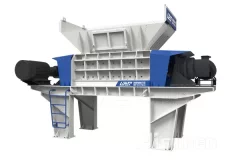
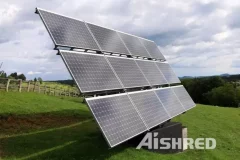
How to Recycle Used Photovoltaic Panels?
2023-02-20Usually the service life of solar photovoltaic panels is about 20-30 years, according to statistics, by 2050 the number of end-of-life photovoltaic panels will be tens of millions of tons, such a huge amount, from the starting point of the circular economy to consider, the recycling of end-of-life photovoltaic panels, in order to achieve the green photovoltaic panels from the source to the end of the environmental protection. So how should the end-of-life photovoltaic panels be recycled? A typical crystalline silicon solar PV panel consists of 65-75% glass, 10-15% aluminium frame, 10% plastic and 3-5% silicon. Recycling is the sorting and reuse of these materials in three main steps: first the PV panel module is dismantled, then it is shredded and finally the valuable metals in the PV panel are extracted by pyrolysis. Shredding as an important part of the recycling process, the photovoltaic panels are first shredded to facilitate the next step of recycling and sorting. Usually choose double-shaft shear
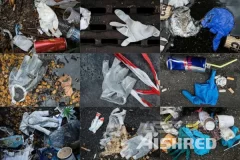
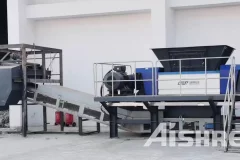
How to Disposal Waste Gloves?
2023-01-31A large number of waste gloves will be produced in industrial production. Some gloves are made of fabric and some are made of rubber. If these waste gloves are directly burned or buried, it will be too wasteful. Waste fabric gloves contain a large amount of fiber and organic matter, which can be used for incineration and power generation after crushing/shredding, and rubber gloves can be used for production of rubber particles after crushing/shredding, which can not only reduce solid waste pollution, but also effectively recycle renewable resources. In the process of recycling waste gloves, shredding is an unavoidable link, which requires a shredder specially developed for waste gloves. The commonly used waste glove shredder is a double-shaft shredder, which processes materials based on the working principle of interaction between cutters. It has good shredding effect on soft and hard materials, and can easily shred a large number of waste gloves. The equipment is designed with low rotational speed and large
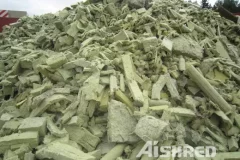
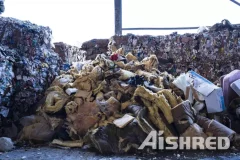
Mineral wool is a general term for a class of industrial products, usually including glass wool, rock wool, slag wool, ceramic fibers, etc. Due to their low density, strong heat resistance, sound absorption, and insulation, they are widely used in thermal insulation, sound insulation, filling, etc. Because of the widespread use of mineral wool, inevitably, a large amount of waste is generated, from two primary sources: manufacturing and post-consumer waste. Whether it is rock wool, glass wool, or slag wool and ceramic fibers, they all have recycling value, they can be used to make new mineral wool products, or as an added component to cement or other products, and can also be used to make other building materials such as recycling bricks. Before recycling mineral wool, there is a key step, shred them into small pieces! You will need one or more industrial shredders for this task. AIShred has a wide range of shredding and sorting equipment for material and energy recovery. Our shredding systems have been used
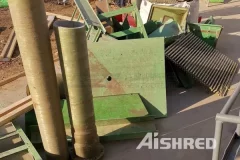

FRP (fiberglass reinforced plastics) products have many advantages, such as high hardness, light weight and corrosion resistance. They are favored by many industrial products and are widely used in chemical industry, engineering, construction, electrical, communication, railway, automobile and other fields. As FRP products gradually reach the life cycle, recycling of waste FRP is becoming a new industry. What equipment is needed to deal with waste FRP? There are generally three directions for the recovery and regeneration of FRP, including chemical pyrolysis, shredding regeneration and energy recovery. First, shredding and regeneration. It is to use the shredder to shred the recycled waste FRP, and sell the FRP fines directly as raw materials, or turn them into FRP, or use them for processing composite materials. Simple and fast operation, typical short, flat and fast business model. Second, energy recovery. This is simpler. You can simply shred the waste FRP, directly package it and sell it to cement plants
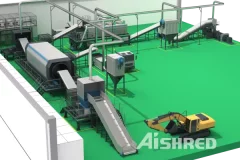
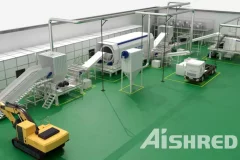
At present, the treatment of industrial waste is not a difficult problem in the industry, but its treatment process will become more complex because of the characteristics of general industrial waste materials. Most of the general industrial wastes belong to composite and low-value wastes. If resources are regenerated directly, the cost of the whole recycling process is high and the process is complex. Therefore, in some industrial or economically underdeveloped places, simple landfill is usually used for disposal, which has a bad effect on the land and environment. In some developed countries and regions, industrial waste is used for collaborative disposal of waste incineration plants, so as to realize energy conversion. At the end of May this year, a customer from Canada finally chose to cooperate with AIShred and purchased a set of industrial waste disposal equipment from our company after multiple inspections and comparisons. Currently, the goods are being prepared.AIShred Disposal Process of Industrial
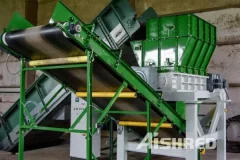
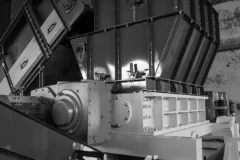
Waste Shredder for Sale in Maldives
2022-07-08AIShred shredders for sale in Maldives are machine for industrial processing of solid waste, not a home appliance. It is used in hotels, recycling centers, waste management departments, waste transfer stations, Landfills, Cement Plants, Manufacturing Plants and so on. The role of the industrial waste shredder is to reduce the size and volume of waste in batches for material recovery, energy conversion, reprocessing or landfilling. AIShred shredders can handle all solid materials, from food waste, to green waste, from biomass, to municipal waste, from industrial waste to C&D waste. Of course, AIShred provides more than waste shredders, we can also provide users with waste sorting and recycling facilities, and issue design drawings. In the past years, the Maldives has been deeply affected by the covid-19 epidemic. Now the haze of the epidemic is gradually dissipating, and many customers from Maldives are already active. AIShred offers various types and sizes of waste shredders in Maldives, from small stand-
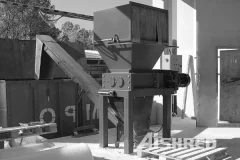
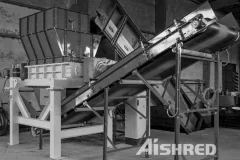
It is undeniable that there are several good industrial shredder manufacturers in the United States and Canada. For some beginners, purchasing from the local area eliminates a series of procedures such as customs clearance, saving time and worry. However, many people still choose to buy from China. Chinese shredders have the same or even higher quality than American products, but the price (product and wearing parts) is much lower. AIShred has already exported its shredders to the United States, in addition, many customers in developed and developing countries have used its machine. if you need, we will be happy to send you some case references of our shredders. Our GD series twin-shaft shredders that outperform competitors in its quality and durability. We provide necessary documentations, witnessed test, spare parts, maintenance and after-sale services. Our single-shaft shredders are effective for processing recyclable waste. Particle size can be adjusted by switching screen to shred into wanted size. Our
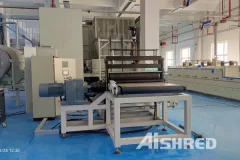
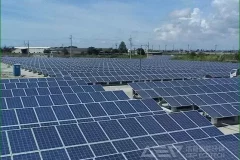
Generally, the service life of solar photovoltaic panels is about 20-30 years. According to statistics, by 2050, the scrapped number of photovoltaic panels will be in the order of ten million tons. Considering the starting point of circular economy, recycling and reusing the scrapped photovoltaic panels can realize the green environmental protection of photovoltaic panels from the source to the terminal. So how should the discarded photovoltaic panels be recycled? Recently, a German company purchased a set of double shaft shear shredder equipment from our company for the disposal, recycling and reuse of solar photovoltaic panels. Crushing is an important part of the recycling process. The photovoltaic panels are first crushed, which is conducive to the next step of recycling and sorting. Usually, double shaft shredder breaking is used to break the photovoltaic panels, and two relatively rotating cutters are used to form the crushing effect of shearing and tearing the materials. The equipment is designed with
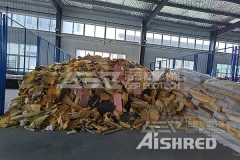
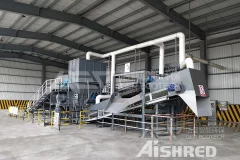
How to Disposal The General Industrial Waste
2022-05-30How to disposal general industrial waste, we should first clarify the purpose of general industrial waste after treatment. After treatment, general industrial waste can be made into rdf/srf, an alternative fuel with high burning value. Compared with fossil fuels, its carbon emission is smaller. It is mostly used in cogeneration projects, and can also be used for collaborative disposal and pyrolysis in cement kilns. It has high economic benefits and fully conforms to the concept of building an energy-saving society. For the treatment of general industrial waste for different purposes, AIShred has launched a series of advanced equipment for the treatment of general industrial waste, and can make different overall treatment schemes for different solid waste materials. Scheme 1: the general industrial waste is transported to the crushing chamber of the industrial waste crusher through the chain plate conveyor for crushing. After the industrial waste is crushed, it is transported through the belt conveyor. At the



